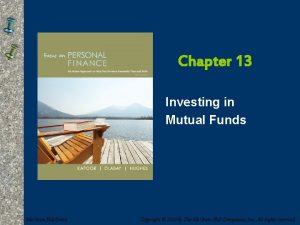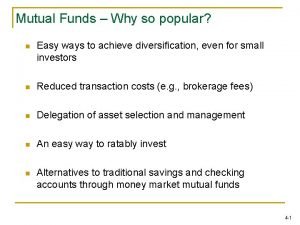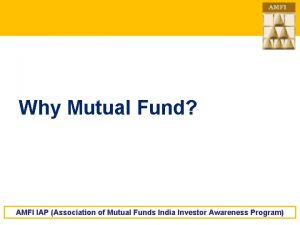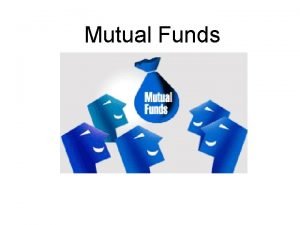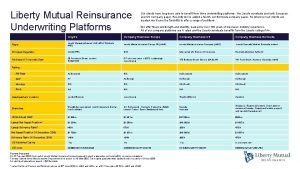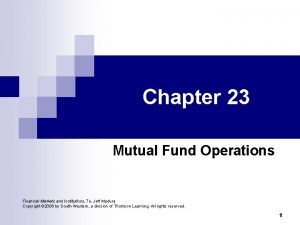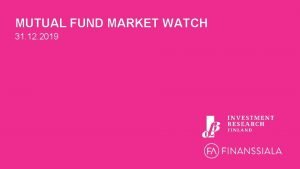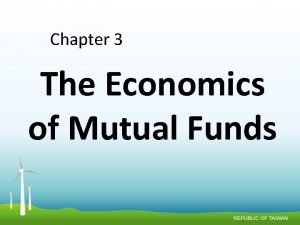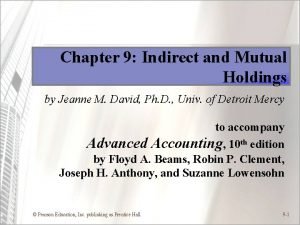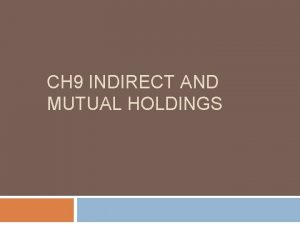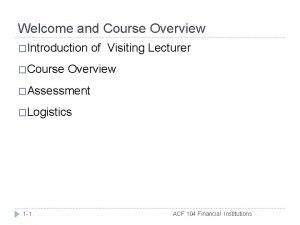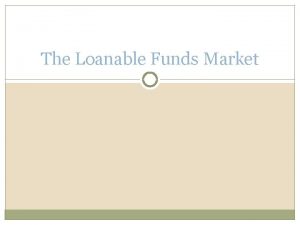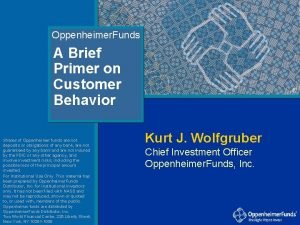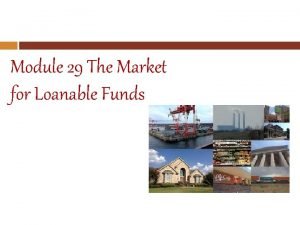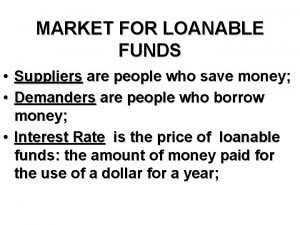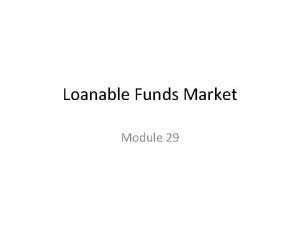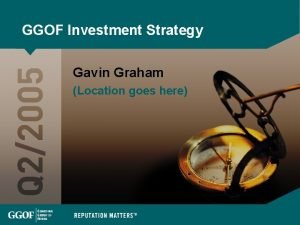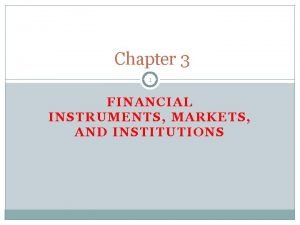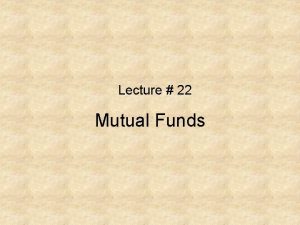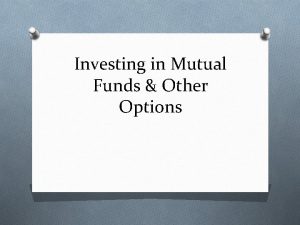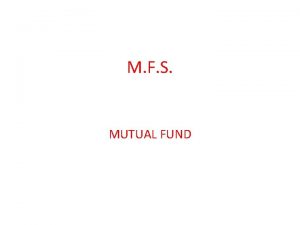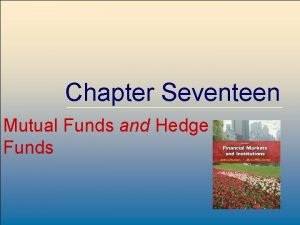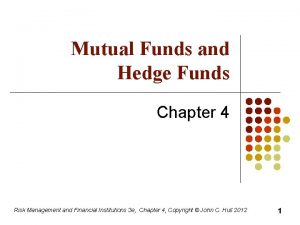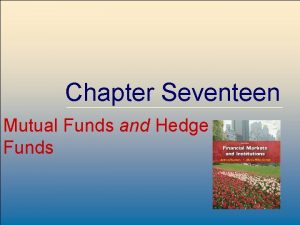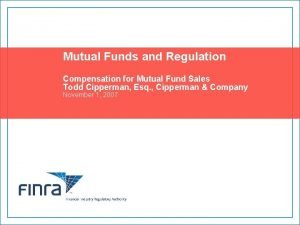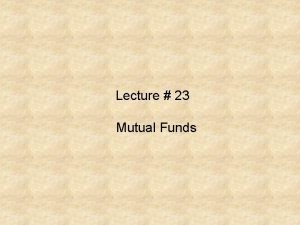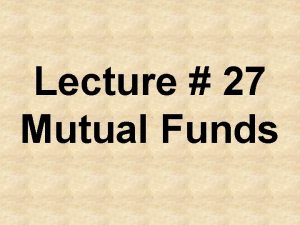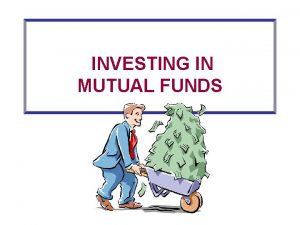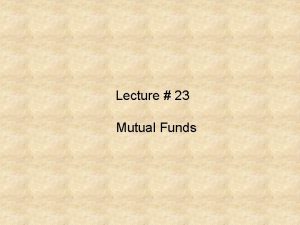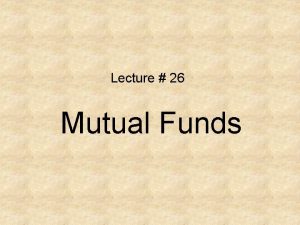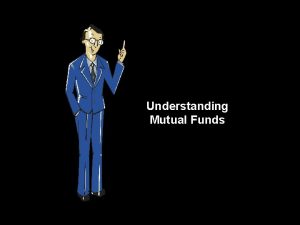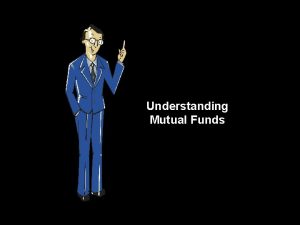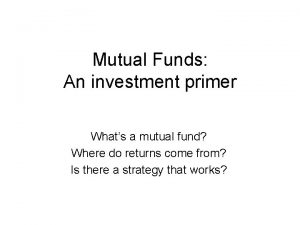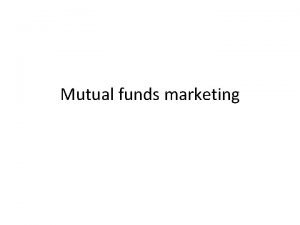Chapter 3 The Economics of Mutual Funds SIZE










































































- Slides: 74

Chapter 3 The Economics of Mutual Funds

SIZE AND STRUCTURE OF THE MUTUAL FUND INDUSTRY • The ICI (2009) reports that net assets of mutual funds worldwide have risen from $11. 9 trillion at year-end 2000 to $19. 0 trillion at year-end 2008. About 51 percent of these net assets are in U. S. mutual funds. The four other countries with more than 3 percent of the global total are Luxembourg (10 percent), France (8 percent), Australia (4 percent), and Ireland (4 percent).

• Although Luxembourg may appear an unexpected member on the list, Khorana, Servaes, and Tufano (2005) note that Luxembourg’s strict bank secrecy laws have helped its mutual fund industry prosper. They find that the sizes of individual countries’ fund industries are positively affected by the existence of regulatory requirements to start a fund and issue a prospectus, and negatively related to the amount of time or money required to set up a fund.

• Based on data from Morningstar (2009), as of December 2008, the U. S. mutual fund industry was composed of 607 fund families (or complexes or sponsors) offering one or more open-end mutual funds to retail and/or institutional investors. Industry membership has fluctuated between 638 families in December 2000 and 576 in December 2005. Despite constituent numbers that would suggest fierce competition, the industry is dominated by relatively few fund families. At yearend 1998, the top 10 mutual fund families had 48 percent of the total assets under management in the open-end fund market. By yearend 2008, the total share for the top 10 was 59 percent.

• The largest mutual fund family in the United States is Vanguard, with about $1. 1 trillion in assets under management at year-end 2008, followed by Fidelity Investments and American Funds with about $0. 9 trillion and $0. 7 trillion, respectively. Vanguard has the largest dollar amount of funds under passive management, while Fidelity has the largest amount actively managed. • This trend toward increased dominance by large fund families is also revealed using the Herfindahl Index, another measure of industry market share concentration.

• The Herfindahl Index is calculated by squaring the market share of each industry constituent and summing across all constituents. • If one fund family has a virtual monopoly, the value would approach 10, 000 (i. e. , ≈1002). The theoretical minimum value for the Herfindahl Index reflects a scenario in which market share is uniformly distributed across industry constituents, and is calculated as 10, 000 divided by the number of industry constituents.

• The Herfindahl Index for open-end mutual funds has risen from 380 in 1998 to 617 in 2008. If assets under management were uniformly distributed across families, the 2008 value would be 10, 000 / 607 = 16. 5. The Herfindahl Index is now 38 times the level of its theoretical minimum value, up from 23 times in 1998. All metrics point to increased industry concentration (see Exhibit 3. 1).


MUTUAL FUND CREATION AND MORTALITY • Membership in the active mutual fund population is dynamic, as the number of mutual funds entering and exiting the scene has remained high. Khorana and Servaes (1999) examine 1, 163 mutual fund starts over a 14 -year period. They find that fund families are more likely to start a new fund if the fund’s investment category objective is broad, if other funds with the same objective have high levels of capital gains overhang (potential tax liability), and if the family has other funds that are stellar performers.

• Fund starts are also related to the proportion of its mutual funds that the management company has in the lowest management fee level. Percent management fees typically are staggered according to the level of assets under management, with the lowest percent fee applying to the largest fund size. Starting a new fund for which the highest fee on the schedule applies—and to which investor flows are likely to come at the expense of one of the family’s lower-fee funds—is consistent with fund family profit maximization (but not necessarily shareholder welfare).

• Karoui and Meier (2008) show that new equity mutual funds often experience strong initial performance but returns tail off quickly. They examine 828 U. S. equity mutual funds that started between 1991 and 2005 and find that in the year immediately after their creation, funds tend to load up on small-cap stocks and bear high levels of unsystematic risk by holding industry-concentrated positions. The starting funds’ average performance declines by 13 basis points per month between year 1 and year 2.

• Mutual funds sometimes experience mortality, which occurs via either merger or liquidation. The former is far more frequent than the latter. Ding (2006) reports that between 1962 and 1999, 1, 751 U. S. mutual funds—one in six in existence—were eliminated through merger. The two most common rationales for these mergers are (1) to take advantage of economies of scale and (2) to eliminate the weaker fund’s inferior historical performance record.

• The three forms of merger, listed in order of decreasing prevalence, are merger of (1) two funds within one family, (2) two funds from different families, and (3) two share classes of one fund. In Ding’s sample of 604 equity fund mergers, 330 involved a target that had the same investment style (e. g. , aggressive growth) as the acquirer, while 274 were crossstyle mergers.

• Jayaraman, Khorana, and Nelling (2002) examine the causes and consequences of mutual fund mergers. Using 742 mergers in a 39 -month period between 2004 and 2007, they find that acquiring funds are larger and have higher premerger performance than target funds. After the merger, a certain degree of wealth transfer occurs, whereby the target fund’s performance improves but the acquiring fund’s performance deteriorates.

• Khorana, Tufano, and Wedge (2007) show that cross-family mergers are more likely if there exists a combination of poor target fund performance and a target fund board that has a large fraction of independent directors. • For boards composed of 100 percent independent directors, the high merger incidence is particularly striking, even relative to boards that are 88 percent independent.

• Although target-fund shareholders tend to benefit from cross-family mergers, each target -fund board member stands to lose an average of $24, 670 in annual director’s fees if his or her board service is discontinued post merger. Evidence suggests that as long as they are not compensated too highly, fully independent boards are more apt to take that step in the service of fund shareholders.

REGULATION • Mutual funds in the United States are subject to a variety of government regulations, among them requirements of the Securities Act of 1933, the Securities Exchange Act of 1934, and the Investment Company Act of 1940. Gremillion (2005) provides an excellent summary of the various legislative acts, their provisions, and the entities that administer them. The Securities Act of 1933 requires funds to register their share offerings and issue a prospectus to investors.

• The offering documents and proxy statements must be filed with the Securities and Exchange Commission (SEC), which was established under the 1934 Act. As noted in Chapter 4, funds are also subject to regulation that caps the fees charged to investors. • The SEC administers the 1940 Act, which covers mutual funds and other types of managed portfolios. The 1940 Act specifies the basic organizational and governance structure of mutual funds, as well as operational measures to protect investors. Among the provisions of the 1940 Act and its amendments is the requirement that fund directors be largely “independent. ”

• The most recent amendment in 2004 required that 75 percent of directors—including the chair of the board—be independent. • The National Association of Securities Dealers (NASD) regulates mutual fund advertising and brokers who sell fund shares. The Internal Revenue Service regulates the degree of portfolio concentration and the tax treatment of mutual funds. Funds must show, on a quarterly basis, that they are properly diversified. Funds must report all dividends received and capital gains realized, both of which are taxed at the fund shareholder level.

SCALE ECONOMIES: EXPENSES AND FEES • A spirited debate has occurred about the possible existence of scale economies in the mutual fund industry, at both the individual fund and family levels. Economies of scale mean that by increasing assets under management, a fund or fund family can spread fixed costs over a larger base and achieve higher profitability from each additional dollar of investor inflows. In a highly competitive industry, scale economies will eventually be reflected in a lower expense ratio charged to investors.

• As shown by Dellva and Olson (1998) and Haslem, Baker, and Smith (2007), fund performance net of fees is negatively related to expense ratios. Malhotra, Martin, and Russel (2007) note that if economies of scale in the industry are confirmed, investors should also have good reason to cheer mutual fund mergers. • Latzko (1999) examines individual mutual funds between 1984 and 1996, finding that the elasticity of expenses to fund assets is less than 1. 0. This result holds across funds specializing in all classes of equity and fixed income investments.

• Latzko interprets this as supporting scale economies, although he finds that expenses decrease rapidly only until fund size reaches about $3. 5 billion. • Researchers have also analyzed scale economies at the level of the fund family. Many fund families share research, trading, and client servicing resources across multiple funds. Thus, the fixed costs associated with those functions are often largely borne at the fund family level.

• Analysis of the year-end 2008 Morningstar data reveals a negative relation between expense ratios and fund family assets managed using active strategies. This result is consistent with the existence of scale economies. Exhibit 3. 2 shows that the average expense ratio for actively managed funds decreases monotonically across active assets under management quintiles, from 2. 12 percent for Quintile 1, which contains the smallest fund families, to 1. 05 percent for Quintile 5. A confounding effect is the possibility that larger families, such as Vanguard, have an abundance of low-cost index mutual funds.

• In order to facilitate an apples-to-apples comparison, Exhibit 3. 2 leaves out assets and expenses for index funds, enhanced index funds, and funds of funds. • Makadok (1999) attempts to detect economies of scale in mutual fund families that offer money market funds. He notes that studies of industries typically assume that any benefits or costs of scale are similar for firms industry-wide. Yet as Makadok points out, certain fund family characteristics lead to savings arising from size while others do not.

• Thus, he finds it useful to estimate separately the magnitude of scale economies for each fund family. • Makadok shows that fund family weightedaverage expense ratios are negatively related to assets under management, which suggests the presence of scale economies. He also hypothesizes that the expense ratio should be negatively related to average account size. Servicing each new client account involves incremental fixed costs.

• All else equal, the larger the average account size (i. e. , the smaller the number of accounts given the assets under management), the smaller the total fixed costs and the lower the expense ratio the fund family can charge. Makadok’s empirical evidence is consistent with this hypothesis and generally confirms the results of Baumol, Koehn, Goldfeld, and Gordon (1990). Dermine and R¨ oller (1992) find similar effects for the French mutual fund industry, but they observe negative scale economies for large fund firms and conclude that there existed an optimal size at that time of about 3 billion French francs.

• Malhotra et al. (2007) examine economies of scope. Some fund families elect to keep a focused product line while others provide investment opportunities in a broad array of market sectors. Malhotra et al. find that the extent to which fund families specialize in strategies has an impact on fees to investors. They report that fund families with a higher degree of “focus” tend to charge lower fees.


SCALE DISECONOMIES: FUND RETURNS • Substantial anecdotal evidence indicates that as fund size grows, generation of a positive alpha is less likely. Chen, Hong, Huang, and Kubik (2004) empirically examine the size–performance relation for mutual funds between 1962 and 1999. Irrespective of whether they measure performance using market-adjusted returns, beta -adjusted returns, a three-factor model, or a fourfactor model, they find that individual fund performance is negatively related to beginning-of -period assets under management.

• As the volume of investment in her fund increases, the superior manager finds it difficult to achieve the same high returns given the increasing portfolio scale, which causes the fund’s alpha to decrease toward zero. Nonetheless, the more superior the manager, the larger the fund will become prior to the time that the return reaches a competitive level. Consequently, the superior manager’s compensation will be higher than that of an inferior manager because her fund size is larger.

BENEFITS OF MUTUAL FUND INVESTING TO FUND SHAREHOLDERS • The benefits of mutual funds to investors are varied. Several of the most notable benefits are discussed next.

Ø Diversification • Mutual fund portfolios reflect a much greater degree of diversification than is typically found in individual stock portfolios. Shawky and Smith (2005) show that the average number of stocks held in equity mutual fund portfolios is about 90, with roughly one-third of the total value in the top 10 stocks. For retail investors in particular, diversifying a portfolio of individual stocks to this level can be a costly and inefficient process. The costs include brokerage fees associated with buying relatively small amounts of many different stocks as well as the record-keeping associated with owning enough names to effectively eliminate unsystematic risk.

Ø Professional Portfolio Management • Related to the diversification advantage, ownership of mutual funds brings professional portfolio management services to fund shareholders. Most professional portfolio managers bring experience at monitoring the entire feasible set of investments, making economically justified decisions about buying and selling individual stocks, and ensuring that each portfolio complies with the characteristics described in the fund’s prospectus.

• This includes structuring the portfolio to set risk and expected return at an appropriate level. Balanced fund and fund-of-funds managers also rebalance the portfolio in a timely way when the stock–bond mix deviates from the target allocation. Professional portfolio management sometimes serves the investor extraordinarily well. Kosowski, Timmermann, Wermers, and White (2006) find that some managers of growth mutual funds are truly exceptional stock pickers who exhibit remarkably persistent high performance even after fees are deducted.

Ready Access to Asset Classes and Market Sectors • By sharing portfolio management costs with fellow fund shareholders, investors gain access to financial markets in an economical way. Further, many mutual funds can be bought directly from the fund family, obviating the need to use brokers and pay their fees.

• Mutual funds provide investors with exposure to a wide array of asset classes. They offer a broad opportunity set, including security types, industry sectors, and geographic sectors. Certain securities, such as those trading on nondomestic exchanges, may be difficult for individual investors to buy directly. Mutual funds provide a means of ownership, albeit indirect. The use of mutual funds designed to invest in a specific market industry sector or capitalization range, or by using a certain style, can help investors keep their portfolios balanced within an asset class.

• For example, many investors are unlikely to know whether a particular stock belongs under the mid -cap value or large-cap growth classification, although the distinction greatly influences eventual returns. Style-adherent mutual funds allow investors to more easily maintain target allocations across these various dimensions. • Finally, certain mutual funds impose screens that help them to invest in a “socially responsible” way. Negative screens often include prohibitions against investments in “sin” businesses such as alcohol, gambling, and tobacco.

• In. March 2009, there were 73 distinct U. S. equity mutual funds that Morningstar designated as socially responsible, with $61. 5 billion in total assets, up from $8. 3 billion at the end of 2000. Despite the increasing popularity of such funds, Girard, Rahman, and Stone (2007) show that between 1984 and 2003, socially responsible fund managers have underperformed their active-fund peers in diversification, selectivity, and market timing.

DRAWBACKS OF MUTUAL FUND INVESTING • Open-end mutual funds also have some drawbacks, which are discussed next.

Ø Persistent High Fees in Some Families • One drawback is that the benefits of costefficient investment are sometimes realized by the fund company and not shared with fund shareholders. Expense ratios, for active management in particular, are sometimes in excess of 3 percent per year. Some funds impose Rule 12 b-1 distribution fees of up to 1 percent annually on their shareholders, and shareholders also have to pay sales loads of up to 8. 5 percent on certain classes of funds.

Ø Underperformance Relative to Index Funds • Another important drawback is that the average, actively managed mutual fund underperforms benchmark indexes and passively managed funds. Berk and Green’s (2004) model and several empirical studies provide strong support for the notion that active mutual fund managers have stockpicking talent and earn persistent positive excess returns gross of fees.

Ø Tax Inefficiency • A further drawback of open-end mutual funds is their tax inefficiency. The relatively high turnover for actively managed funds is costly to fund shareholders in terms of transaction costs as well as in creating short-term taxable gains. Moreover, the redemption decisions of other investors can trigger tax liabilities for the fund shareholders left behind. Although the number and size of tax-efficient mutual funds are growing fast, many investors in actively managed funds continue to see a wide gap between their pre-tax and after-tax returns.

Ø Inadequate Disclosure • Mutual fund information transparency has improved in certain ways (e. g. , the more frequent disclosure of portfolio holdings), but disclosure has lagged in other areas. One prime area is portfolio trading costs. Edelen et al. (2007) find, in confirmation of Wermers’ (2000) results, that the magnitude of mutual fund trading costs is approximately equal to the expense ratio. Even for those investors who know that trading costs are not included in the expense ratio, this number is certainly higher than most imagine.

• Mutual funds disclose their portfolio holdings relatively infrequently, and even then, fund shareholders have a rightful concern about window dressing. Between 1985 and 2004, the Securities and Exchange Commission (SEC) required mutual funds to disclose portfolio holdings semiannually. Starting in May 2004, quarterly disclosure was mandated. Examining the period before mandatory quarterly disclosure, Ge and Zheng (2006) report that many mutual funds voluntarily is closed their holdings quarterly. They find that the effects of more frequent disclosure asymmetric.

• For the top-performing 20 percent of funds, those disclosing quarterly had lower performance than those disclosing semiannually. For the bottom-performing 20 percent of funds, those disclosing semiannually had lower performance than those disclosing quarterly. Ge and Zheng conclude that top-performing funds may lose some informational advantage through increased disclosure. They state that poor-performing funds may suffer from agency costs that are greater than any informational value managers hold. They conclude that more frequent disclosure is appropriate for these funds.

FINANCIAL BARRIERS TO MUTUAL FUND INVESTING AND REDEMPTION • Mutual fund load charges are discussed in Chapter 4. Apart from this cost, many mutual funds impose a barrier in the form of the minimum initial investment amount. Incremental costs arise in servicing each new investor’s account, and fund companies want to avoid taking on accounts whose fees do not cover those costs.

• At year-end 2008, the median retail class fund required an initial investment of $1, 000, although 513 retail funds require no minimum initial investment. Over 500 retail class funds have a minimum investment of $25, 000 or more. The median retail fund’s investment required to start an individual retirement account (IRA) is only $250. The presumption of mutual funds is that an investor’s initial IRA investment will be followed by many subsequent investments. If these do not materialize and the account balance remains low, fund companies often charge account maintenance fees.

• For institutional class funds, the minimum investment is as high as $250 million. At year-end 2008, over 500 funds had minimums of $50 million or higher. The median institutional class fund required a $100, 000 initial investment. • Redeeming shares is not always a cost-free process for investors. As noted in Chapter 4, deferred load charges are frequently found on class-B fund shares. In addition, many mutual funds charge redemption fees, particularly for redemptions that occur in the few months immediately following the share purchase.

• Quick in-and-out trading by fund shareholders can greatly complicate the fund flows-andinvestment balancing job of portfolio managers, can be administratively costly for the mutual fund family, and can be potentially damaging to the after-tax returns of fellow fund shareholders. Mutual funds impose redemption fees to discourage investors from using funds as trading rather than investment vehicles.

• Exhibit 3. 3 gives some perspective on the current prevalence and size of redemption fees in the United States. Almost one-fourth of equity funds (defined as distinct funds with 80 to 100 percent of the portfolio invested in U. S. common stocks) impose a redemption fee of some type. Most common is to charge a 2 percent fee if redemption occurs within one month of the shares’ purchase, although across all holding periods, 2 percent remains the predominant fee amount.


MUTUAL FUND GOVERNANCE AND AGENCY PROBLEMS • Weak mutual fund governance is probably the most pernicious drawback for many fund investors. As the governance of public corporations has increased in prominencever the past decade, so has the topic of mutual fund governance. In their discussion of mutual fund board characteristics, Tufano and Sevick (1997) provide a lucid description of the structure of open-end mutual funds in the United States:

• Tufano and Sevick (1997) analyze whether a mutual fund’s fees are related to its board’s characteristics. They find that lower fees to investors are associated with boards that are smaller and that have a larger proportion of independent directors. Lower fees are also observed in funds whose board members serve on other boards within the fund family. Tufano and Sevick emphasize that their results should not be over interpreted to imply that certain board structures produce low fees. They raise the possibility that fund families with low fees gravitate toward certain types of board structures.

• Evaluation of mutual fund governance involves at least two major components: whether the corporate culture of the fund family fosters a sensible investment and communication process that is clientcentered, and whether the fund’s board members are well positioned to act in shareholders’ interests. • Morningstar provides grades of corporate culture (A through D) and board quality (Athrough C).

Morningstar Principia (2009) describes the corporate culture evaluation process as answering four questions: • 1. Is the fund company focused on investing or gathering assets? • 2. Does the fund company foster a thoughtful, repeatable investment process? • 3. Is the fund company straightforward with investors through clear, pertinent disclosure and responsible marketing? • 4. Do talented investors spend their careers at this fund firm?

The board quality evaluation process involves answering three questions: • 1. Does the board consistently act in shareholders’ best interest? • 2. Do the independent directors have meaningful investments in the fund? To earn the maximum score here, at least 75 percent of a board’s independent directors must have more money invested in the funds they oversee than they receive in aggregate annual compensation for serving on the board. • 3. Is the board led by an independent chairman, and are 75 percent of the directors independent?

• Exhibit 3. 4 shows the number of fund families, as of December 2008, that received various Morningstar grades for corporate culture and board quality. Families receiving grades of “A” in both criteria for all their funds include Clipper, FPA, Longleaf Partners, and Selected Funds. • Freeman (2007) argues that mutual fund industry governance in general has failed. If boards of directors acted in their designated capacity as fiduciaries, mutual fund fees would reflect competitive pricing. Freeman says that if prices were at competitive levels, they would be much lower than they are now.

• As evidence of the noncompetitive state of mutual fund pricing, one can consider the prices that mutual fund advisers charge non– mutual fund clients for identical services. For example, Freeman (2007) found that the mutual fund family then known as Alliance Capital managed equity portfolios for other fund companies and retirement systems and charged 10 to 24 basis points per year while at the same time charging its own open-end mutual fund shareholders 93 basis points.


FUND MANAGER TOURNAMENT BEHAVIOR • Relatively minor differences in returns across mutual funds often produce large differences in investor flows. Chevalier and Ellison (1997) find that funds exhibiting annual outperformance of 20 percent attract next-year flows that are twice the level for funds that outperform by 15 percent. They find a negative effect, though much weaker, for funds that are the very worst performers. Sirri and Tufano (1998) also report a strong relation between mutual fund performance and investor flows, but it is asymmetric.

• Funds that outperform receive high inflows while funds that underperform do not experience the same degree of outflows. The relation is stronger for funds that charge high fees. Sirri and Tufano comment that high fees likely indicate a vigorous fund marketing effort, which is apt to bring investor attention to a fund. Weak performance is never advertised by the fund family, so relatively unsophisticated investors may not be primed to react to those results.

• In view of the high sensitivity of investor flows to the degree of outperformance and given that portfolio manager compensation typically is linked to assets under management, managers have strong incentives to outperform by a large margin. Numerous authors have examined how mutual fund performance during the first months of the year affects portfolio managers’ risk-taking behavior during the balance of the year. Schwarz (2009) summarizes the sometimes-conflicting results of past studies, and makes a key methodological contribution that reconciles those results.

• Examining funds between 1990 and 2006, he confirms the findings of the original Brown, Harlow, and Starks (1996) study: Low-performing managers from the year’s first half consistently increase their risk levels in the second half. The Brown et al. (1996) and Schwartz (2009) results reveal manager behavior consistent with a multistage tournament, in which their primary objective is to maximize personal compensation. This aim can be achieved when a manager betters her position relative to other managers, attracting increased investor flows and assets under management.

FUND FAMILY MARKETING AND CROSS-SUBSIDIZATION • Gaspar, Massa, and Matos (2006) report striking results about mutual fund families’ steps to enhance overall family profits by favoring certain of their funds at the expense of others (crosssubsidization). Specifically, they favor funds that carry high fees and funds with past outperformance. In terms of attracting flows, it is much more valuable for a mutual fund family to have one star fund and one laggard fund than to have two average-performing funds.

• Therefore, families have incentives to nurture the star funds, or at least to encourage investor flows into high-fee funds. • One mechanism by which this is done is to allocate superior opportunities, such as hot initial public offerings, to more favored funds. Another is to conduct cross-trading between more favored and less favored funds such that more favored funds do not have to bear the price-pressure cost normally imposed by open market transactions.

• The net benefit to more favored funds over less favored funds averages 0. 7 to 3. 3 percent per year between 1991 and 2001. The authors note that despite all the reputed benefits of crossing trades, regulators and investors should be concerned about intra family crosstrades creating problems that are known to arise with self-dealing.

CONCLUSIONS • The mutual fund industry worldwide has grown dramatically in recent years. In the United States, industry market share has become much more concentrated in the past decade, with almost 60 percent of assets under management now invested with 10 fund families.

• The process of mutual fund creation and mutual fund mortality takes place continuously. For a fund, mortality typically occurs by being merged into another fund. This process tends to be economically beneficial to target fund shareholders but less so for acquiring-fund shareholders. Cost savings through scale economies are not sufficient to offset other negative impacts of mergers. The target’s board structure is an important determinant of whether a merger takes place.

• Government regulation is a major feature in the U. S. mutual fund industry. The business process is influenced primarily by the Investment Company Act of 1940 and its amendments. The Act stipulates that mutual funds register with the SEC, maintain board independence, and that the board must vote on all major contracts. Other regulations come from the Securities Act of 1933, the Internal Revenue Service, and self-regulatory organizations.

• Economies of scale, at least to a point, are evident in mutual fund families. Fees charged to investors are generally lower for larger funds. Portfolio managers, however, find it more difficult to maintain superior investment performance as fund size grows. Performance is often hindered by high trading costs, which can be triggered by both discretionary trades as well as investor fund flows.

• Mutual funds provide individual investors with numerous benefits, including ready diversification, professional portfolio management, and inexpensive access to asset classes and market sectors. Among the drawbacks to mutual funds are noncompetitive fee levels, tax inefficiency, a general failure to outperform benchmark indexes, and poor disclosure policies. Mutual fund investors also face barriers to purchasing and selling shares. These take the form of minimum initial investment levels and redemption fees, respectively.

• Given that mutual funds are designed as investment vehicles rather than trading vehicles, most investors do not find these barriers to be prohibitive. • Mutual fund governance is one of the issues that affects investment results most profoundly. Fund boards are responsible for hiring the portfolio manager and negotiating management fees. The board is required to attest that the fees are not excessively high and otherwise to act in fund shareholders’ interests.

• Evidence suggests that boards that have even more than the SEC’s mandated 75 percent of independent directors tend to perform better for investors. On average, portfolio management fees do not appear to be set as if the market is competitive, and management companies frequently charge far higher fees to open-end mutual funds than they do to other institutional investors for equivalent services.

• Evidence suggests that achieving higher profitability through maximization of fund flows is extremely important to mutual fund families. Among the ways to increase flows is by taking steps to become a star fund. Managers tend to adjust their late-year risk taking in order to make the list of top funds. There is also evidence supporting the idea that fund families use weak funds in various ways to subsidize strong ones, possibly to help the strong funds reach the top tier.
 Chapter 13 investing in mutual funds
Chapter 13 investing in mutual funds Mutual funds examples
Mutual funds examples Iap mutual funds
Iap mutual funds Mutual funds disclaimer
Mutual funds disclaimer Mutual fund disclaimer
Mutual fund disclaimer Meritas mutual funds
Meritas mutual funds Reinsurance mutual funds
Reinsurance mutual funds Mutual fund operations
Mutual fund operations Aim mutual funds
Aim mutual funds Mutual funds market watch
Mutual funds market watch Us mutual fund industry size
Us mutual fund industry size Maastricht university school of business and economics
Maastricht university school of business and economics Elements of mathematical economics
Elements of mathematical economics Indirect and mutual holdings chapter 9
Indirect and mutual holdings chapter 9 Indirect and mutual holdings
Indirect and mutual holdings Const name void
Const name void Size separation can be used
Size separation can be used Hình ảnh bộ gõ cơ thể búng tay
Hình ảnh bộ gõ cơ thể búng tay Bổ thể
Bổ thể Tỉ lệ cơ thể trẻ em
Tỉ lệ cơ thể trẻ em Gấu đi như thế nào
Gấu đi như thế nào Glasgow thang điểm
Glasgow thang điểm Chúa yêu trần thế alleluia
Chúa yêu trần thế alleluia Các môn thể thao bắt đầu bằng từ đua
Các môn thể thao bắt đầu bằng từ đua Thế nào là hệ số cao nhất
Thế nào là hệ số cao nhất Các châu lục và đại dương trên thế giới
Các châu lục và đại dương trên thế giới Công thức tiính động năng
Công thức tiính động năng Trời xanh đây là của chúng ta thể thơ
Trời xanh đây là của chúng ta thể thơ Mật thư anh em như thể tay chân
Mật thư anh em như thể tay chân Phép trừ bù
Phép trừ bù Phản ứng thế ankan
Phản ứng thế ankan Các châu lục và đại dương trên thế giới
Các châu lục và đại dương trên thế giới Thơ thất ngôn tứ tuyệt đường luật
Thơ thất ngôn tứ tuyệt đường luật Quá trình desamine hóa có thể tạo ra
Quá trình desamine hóa có thể tạo ra Một số thể thơ truyền thống
Một số thể thơ truyền thống Cái miệng nó xinh thế chỉ nói điều hay thôi
Cái miệng nó xinh thế chỉ nói điều hay thôi Vẽ hình chiếu vuông góc của vật thể sau
Vẽ hình chiếu vuông góc của vật thể sau Nguyên nhân của sự mỏi cơ sinh 8
Nguyên nhân của sự mỏi cơ sinh 8 đặc điểm cơ thể của người tối cổ
đặc điểm cơ thể của người tối cổ Thế nào là giọng cùng tên?
Thế nào là giọng cùng tên? Vẽ hình chiếu đứng bằng cạnh của vật thể
Vẽ hình chiếu đứng bằng cạnh của vật thể Tia chieu sa te
Tia chieu sa te Thẻ vin
Thẻ vin đại từ thay thế
đại từ thay thế điện thế nghỉ
điện thế nghỉ Tư thế ngồi viết
Tư thế ngồi viết Diễn thế sinh thái là
Diễn thế sinh thái là Các loại đột biến cấu trúc nhiễm sắc thể
Các loại đột biến cấu trúc nhiễm sắc thể Bảng số nguyên tố lớn hơn 1000
Bảng số nguyên tố lớn hơn 1000 Tư thế ngồi viết
Tư thế ngồi viết Lời thề hippocrates
Lời thề hippocrates Thiếu nhi thế giới liên hoan
Thiếu nhi thế giới liên hoan ưu thế lai là gì
ưu thế lai là gì Hổ sinh sản vào mùa nào
Hổ sinh sản vào mùa nào Khi nào hổ con có thể sống độc lập
Khi nào hổ con có thể sống độc lập Sơ đồ cơ thể người
Sơ đồ cơ thể người Từ ngữ thể hiện lòng nhân hậu
Từ ngữ thể hiện lòng nhân hậu Thế nào là mạng điện lắp đặt kiểu nổi
Thế nào là mạng điện lắp đặt kiểu nổi Sources and uses of funds
Sources and uses of funds Basic flow of funds through the financial system
Basic flow of funds through the financial system Uab comp clinic
Uab comp clinic Loanable funds shifters
Loanable funds shifters Shareholders equity and shareholders funds
Shareholders equity and shareholders funds Funds from operations
Funds from operations Oppenheimer funds customer service
Oppenheimer funds customer service Module 29 featured worksheet the market for loanable funds
Module 29 featured worksheet the market for loanable funds Who are the demanders of loanable funds
Who are the demanders of loanable funds Demand for loanable funds curve
Demand for loanable funds curve Supply shifters for loanable funds market
Supply shifters for loanable funds market Ggof
Ggof Analysis of fund flow statement
Analysis of fund flow statement Prime funds calgary
Prime funds calgary Deped order 8 s. 2007
Deped order 8 s. 2007 Financial markets instruments and institutions
Financial markets instruments and institutions
